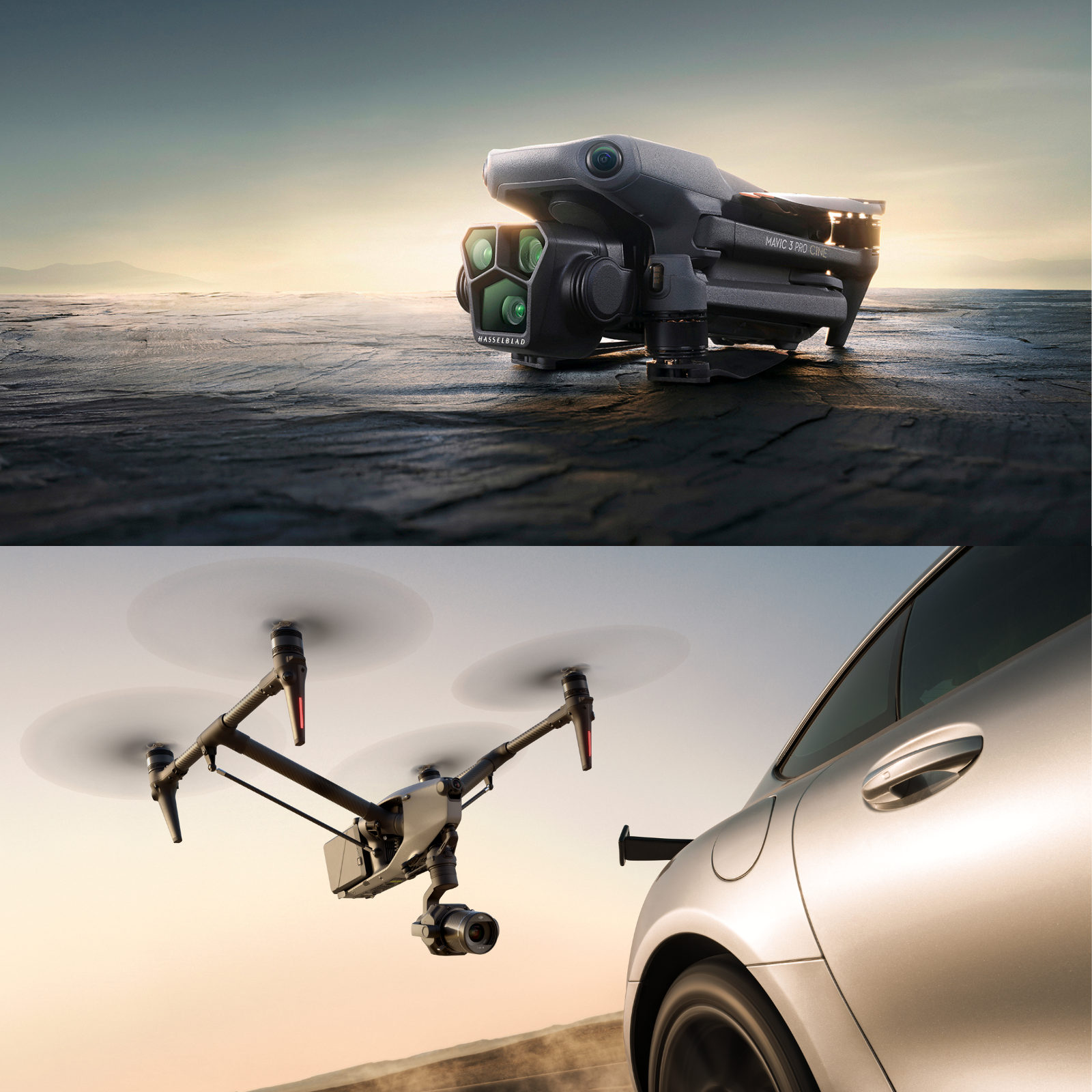
Products
DJI Mavic 3 Pro Cine Vs DJI Inspire 3
In-depth comparison between the DJI Mavic 3 Pro Cine and the DJI Inspire 3. Both drones are engineered for top-class aerial filmmaking. Read this blog to find out which one is best for your needs, or whether both drones have a place in your ... Read More
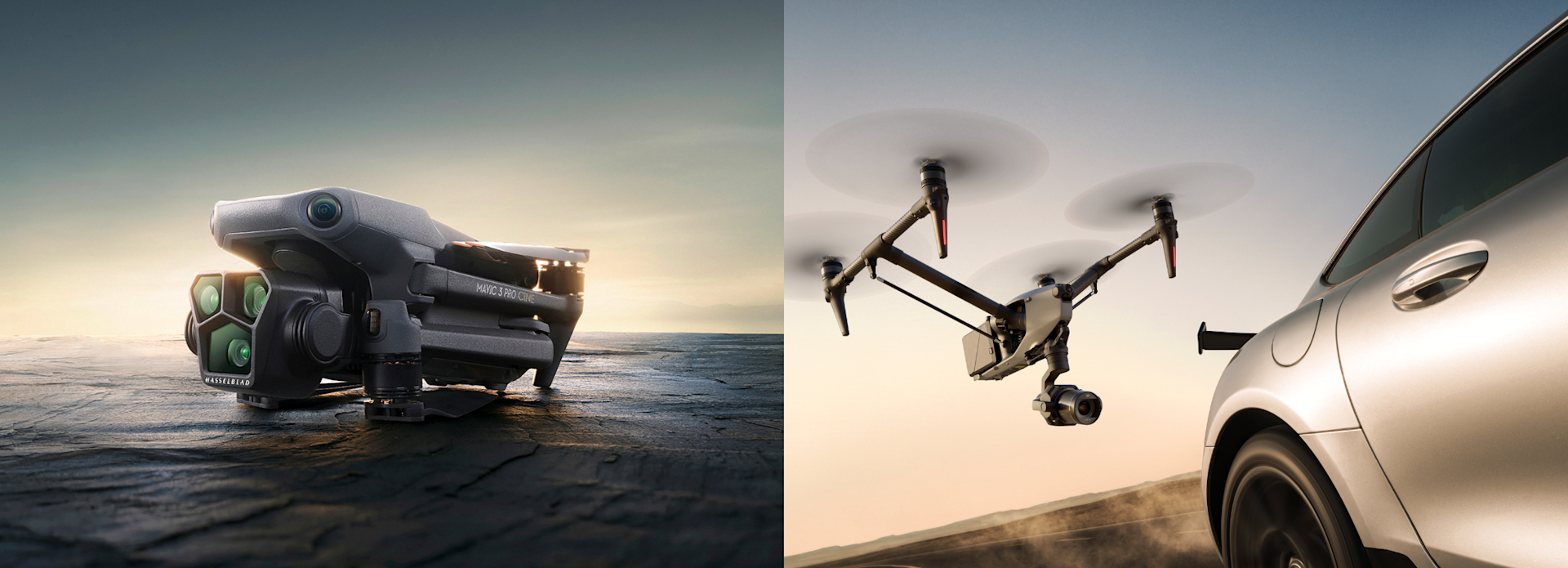
Find out the key differences between the DJI Mavic 3 Pro Cine and DJI Inspire 3;
Both drones are engineered for top-class filmmaking, with Apple ProRes support;
DJI Inspire 3 can capture up to 8K/75fps, while the DJI Mavic 3 Pro Cine tops out at 5.1K/50fps;
Mavic 3 Pro Cine integrates three cameras with different focal lengths; Inspire 3 uses the X9-8K Air with interchangeable lenses;
Filmmakers may decide that both the Mavic 3 Pro Cine and Inspire 3 have a place in their portfolio, offering versatility depending on the nature of the job.
It's been a busy month for DJI, releasing two premium content creation drones in under a fortnight.
The Mavic 3 Pro Cine (part of the Mavic 3 Pro drone series) follows hot on the heels of the DJI Inspire 3.
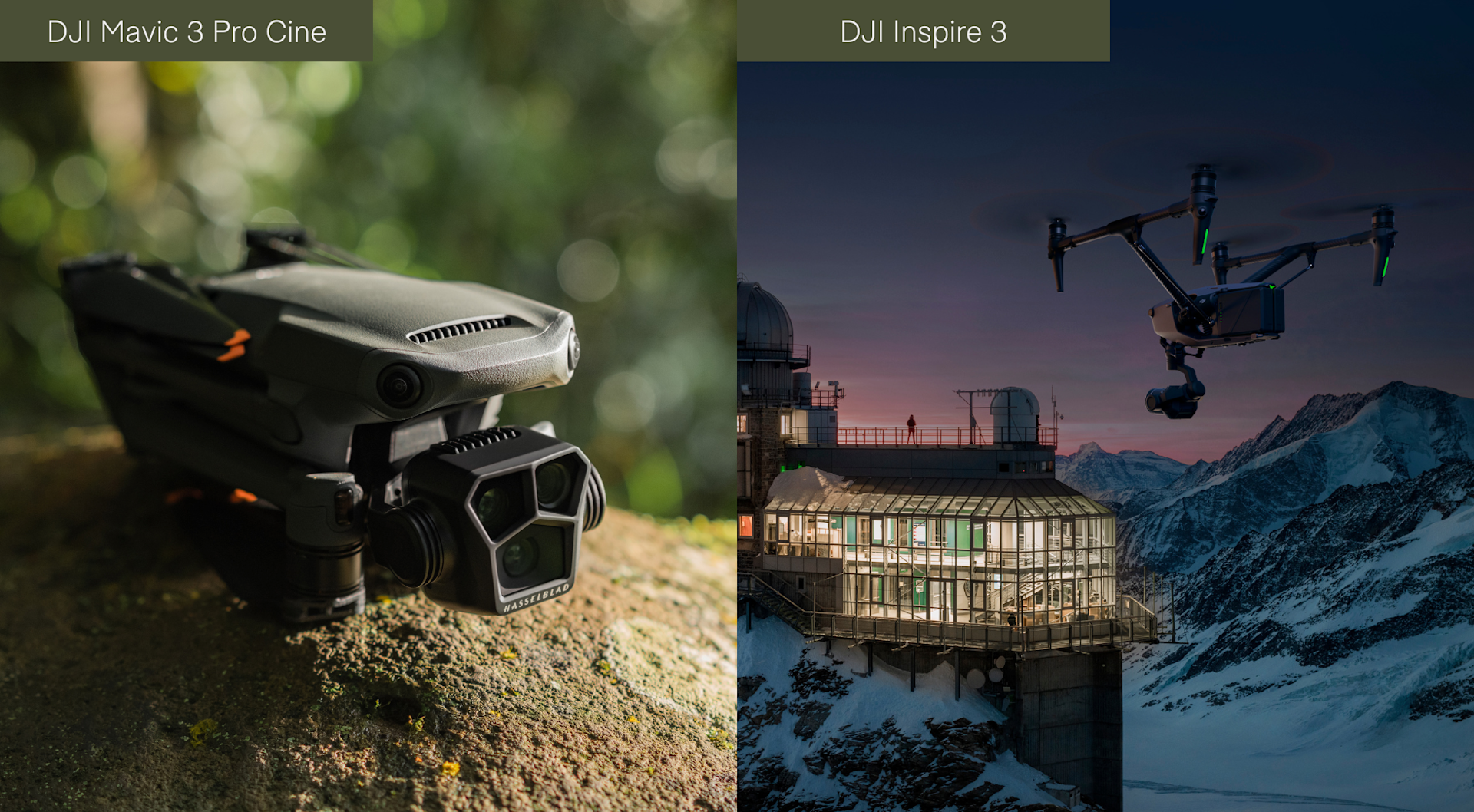
Both aircraft are designed for top-class aerial filmmaking - but with each having their unique features, which one is best, and for what purpose?
We'll explore this in this blog, comparing the DJI Mavic 3 Pro Cine and DJI Inspire 3.
DJI Mavic 3 Pro Cine Vs DJI Inspire 3: Key Specifications
The table below provides an overview of the key specifications between the DJI Mavic 3 Pro Cine and DJI Inspire 3.
DJI Mavic 3 Pro Cine | DJI Inspire 3 | |
Payload | Native triple camera | X9-8K Air |
Sensor Size | 4/3 CMOS 1/2-inch CMOS 1/1.3-inch CMOS | 36*24mm Full-frame |
Max Resolution | 5.1K/50fps 4K/120fps | 8K/75fps 4K/120fps |
Dynamic Range | 12.8 stops | 14+ stops |
Focal Length | 24mm (f/2.8-f/11) 70mm (f/2.8) 166mm (f/3.4) | DL Mount: 18/24/35/50mm f/2.8 |
Video Format | Apple ProRes | CinemaDNG Apple ProRes |
Storage | Internal Storage (1TB) | External Storage (PROSSD 1TB) |
Max Battery Life | 43 minutes | 28 minutes |
Max Speed | 21 m/s | 26 m/s |
Max Wind Speed Resistance | 12m/s | Take-off/landing: 12 m/s In-flight: 14 m/s |
Weight | 963g | Approx. 3,995 g (includes gimbal camera, two batteries, lens, PROSSD, and propellers); Max Take-off Weight: Approx. 4,310 g |
Max Transmission Distance (CE) | 8km | 8km |
Positioning Accuracy | Metre-level | Centimetre-level |
Obstacle Sensing Capability | Omnidirectional | Omnidirectional |
FPV Camera | No | 161 FOV 1/1.8-inch night vision sensor |
Controller | DJI RC Pro | DJI RC Plus |
Camera/Imaging System
With the DJI Mavic 3 Pro Cine and Inspire 3 being content-creation drones, it seems sensible to start with a look at the cameras and associated imaging systems.
The Mavic 3 Pro Cine has an integrated triple camera, featuring a Hasselblad 4/3 CMOS, a Medium Tele Camera, and a second Tele camera.
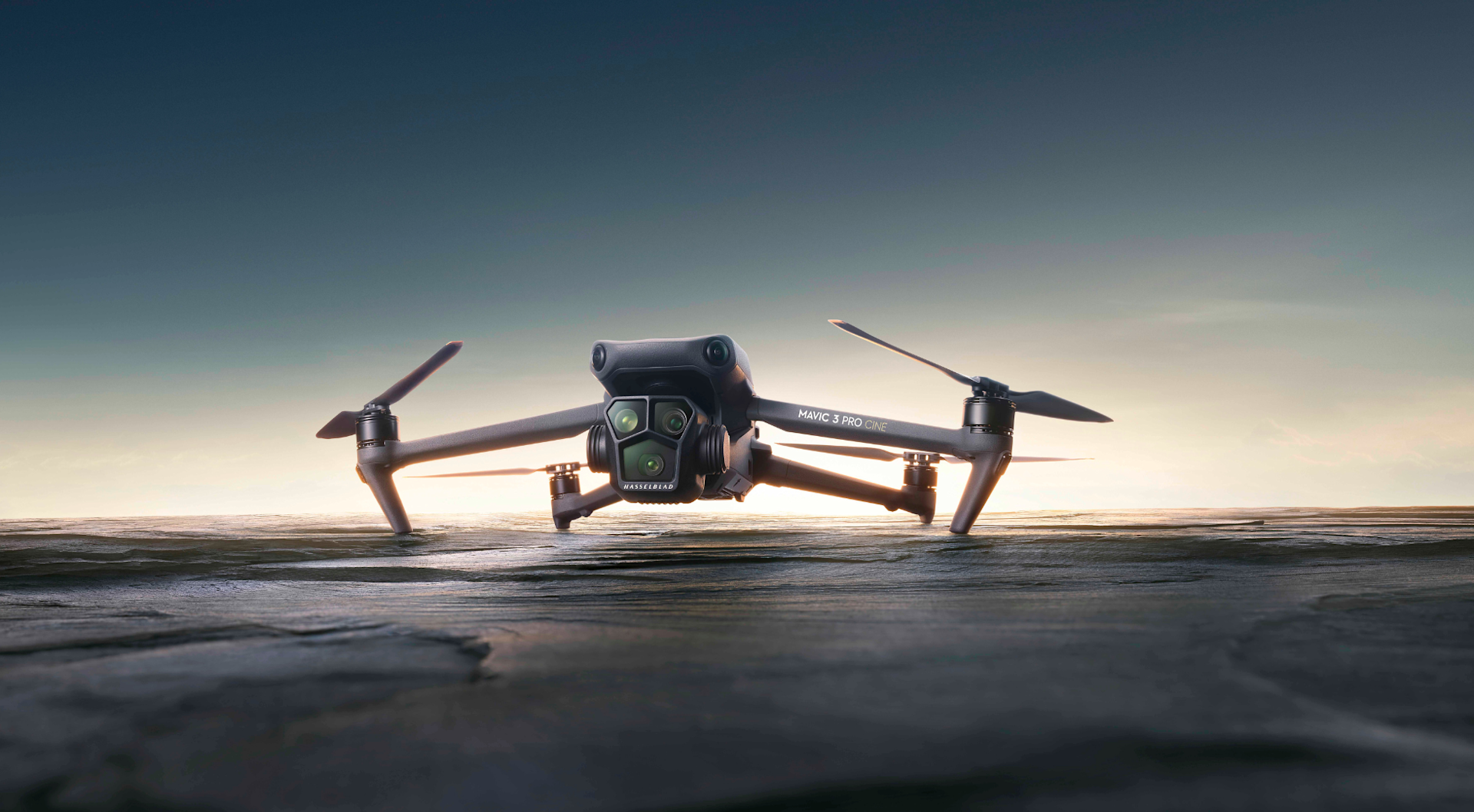
Utilising the Hasselblad camera, the Mavic 3 Pro Cine tops out at 5.1K/50fps video, while it can also capture DCI 4K/120fps. Meanwhile, the two Tele cameras can shoot 4K/60fps video.
All three cameras support Apple ProRes (Apple ProRes 422 HQ, Apple ProRes 422, and Apple ProRes 422 LT encoding), which comes with the drone. To complement this, the Mavic 3 Pro Cine has 1TB SSD internal storage.
In contrast, the DJI Inspire 3 takes things up a notch. Integrated with the powerful X9-8K Air gimbal and supporting DJI's latest image processing system, CineCore 3.0, the Inspire 3 supports internal recording of up to 8K/25fps with CinemaDNG, as well as 8K/75fps Apple ProRes RAW video - meeting the needs of top-class film and TV productions.
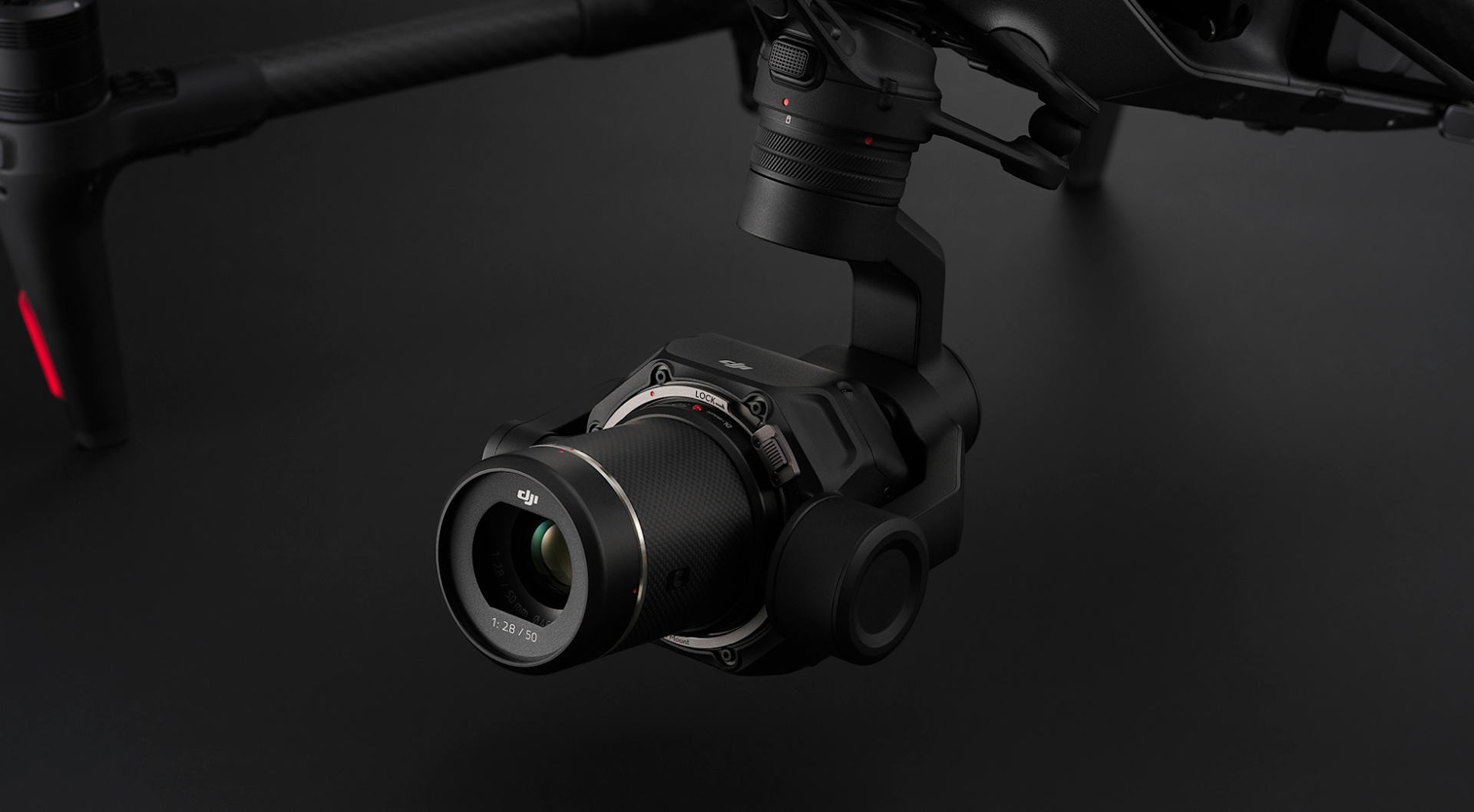
It can also capture up to full-frame 4K/120fps ProRes RAW video without cropping.
The CinemaDNG and Apple ProRes codecs need to be purchased separately, and the drone uses external storage (PROSSD 1TB) which comes with the drone.
In terms of the sensor size, the X9-8K camera is a whopping 35mm full-frame CMOS, while the Mavic 3 Pro Cine features a 4/3 Hasselblad CMOS, 1/1.3 Medium Tele Camera, and 1/2-inch Tele camera.
Both drones offers filmmakers versatility when it comes to focal lengths.
The X9-8K integrates the new DL 18mm F/2.8, as well as the 24mm, 35mm and 50mm F/2.8 which are also compatible with the Inspire 2. These lenses need to be purchased separately. A new telephoto lens will be released later.
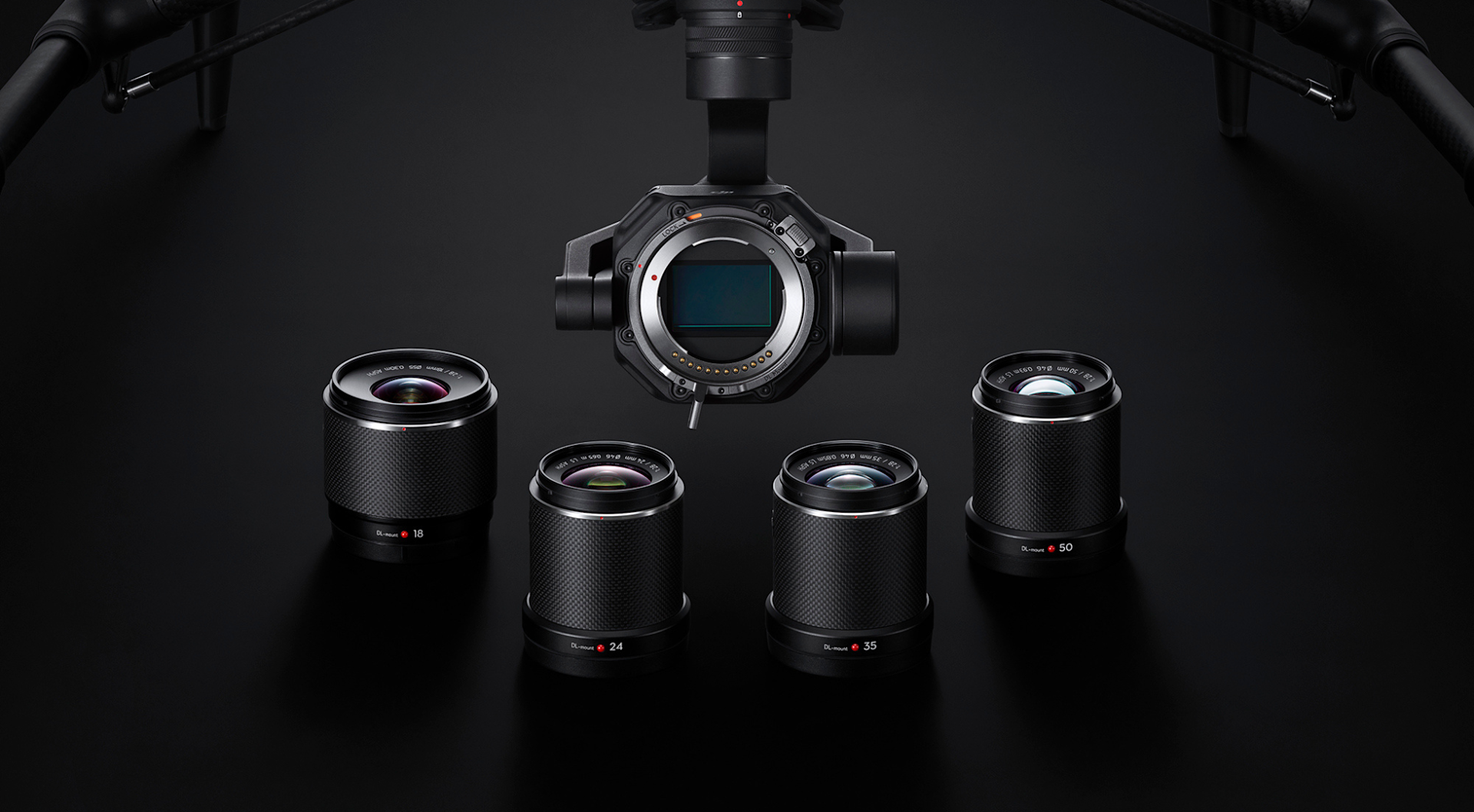
Meanwhile the Mavic 3 Pro Cine's integrated cameras have varying focal lengths.
Hasselblad Camera: 24mm, f/2.8-f/11
Medium Tele Camera: 70mm, f/2.8
Tele Camera: 166mm, f/3.4
The X9-8K Air supports dual native ISO and covers 14+ stops of dynamic range, while the Mavic 3 Pro Cine's Hasselblad camera supports 12.8 stops of dynamic range. Higher dynamic range enables more possibilities during post-editing, retaining genuine colour, even after significant exposure adjustments.
Design: Mavic 3 Pro Cine vs Inspire 3
One of the biggest differences between the two drones is their design.
The Mavic 3 Pro Cine is a much smaller, lighter and compact drone, perfectly suited to capturing content on the go, weighing 963g.
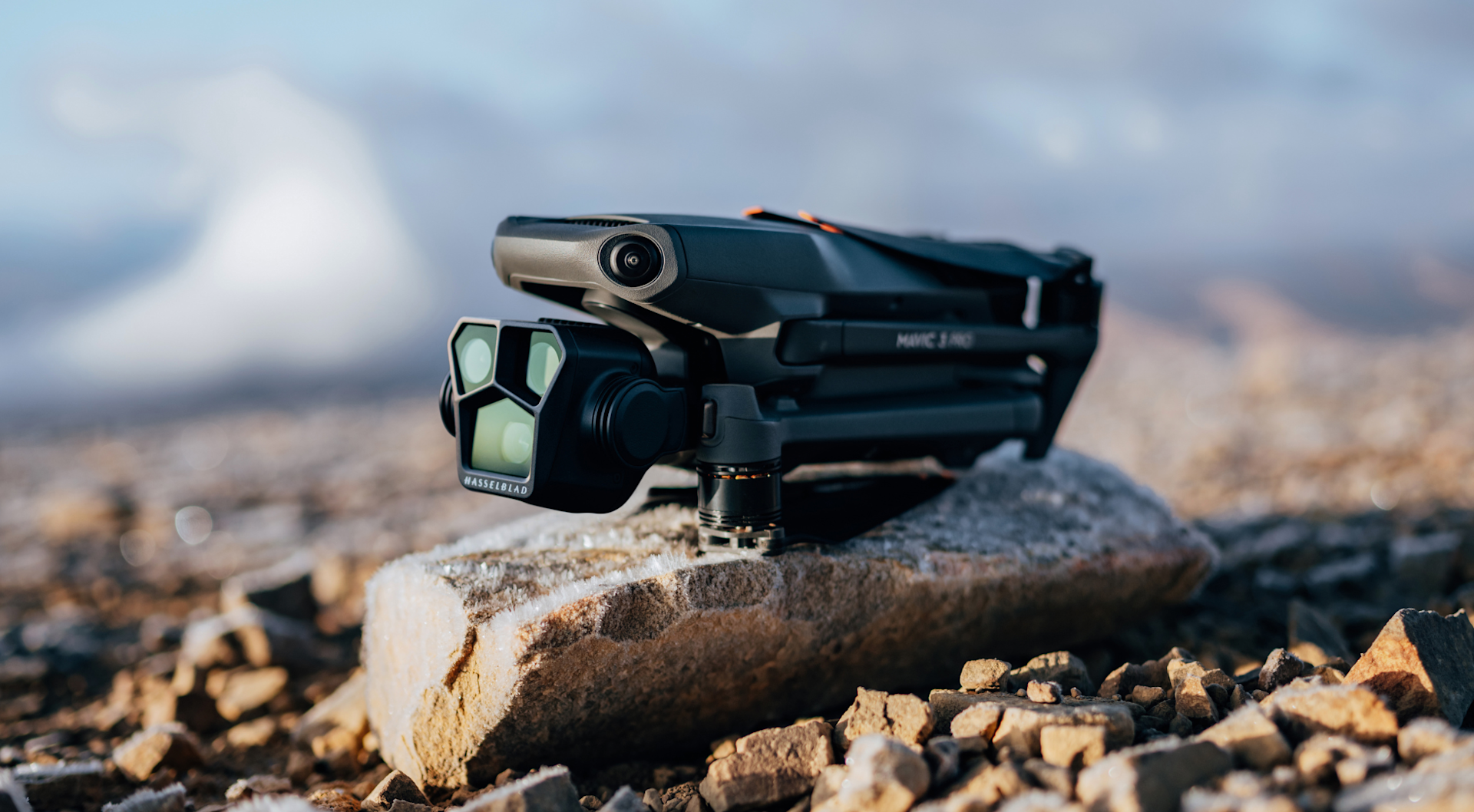
Meanwhile, the Inspire 3 is more of a heavy-lift aircraft. Its maximum take-off weight is 4,310g, although a set-up featuring the gimbal camera, two batteries, lens, PROSSD, and propellers tips the scales at 3,995g.
While the Inspire 3 isn't as portable as the Mavic 3 Pro Cine, it does come with new foldable quick-release propellers which help storage and don't require re-installation before each flight, while the newly-designed trolley case has been engineered for easier transportation.
On the design front, the DJI Inspire 3's new look does allow it to support 360° Pan and Tilt Boost structures. When the landing gear is lowered, the gimbal supports obstruction-free 80° upward-angle shooting. This is a major advantage for filmmakers.
Performance
The DJI Mavic 3 Pro Cine and DJI Inspire 3 pack plenty into their performance specifications.
Speed And Agility
The DJI Inspire 3 might be the larger, heavier drone - but it is just as agile, and is even quicker; ideal for fast-moving scenes like high-speed car-chase scenes.
The table below shows these key statistics.
Mavic 3 Pro Cine | Inspire 3 | |
Max Horizontal Speed | 21 m/s (46.9mph) | 26 m/s (58 mph) |
Max Ascent Speed | 8 m/s | 8 m/s |
Max Descent Speed | 6 m/s | Vertical: 8 m/s Tilt: 10 m/s |
Operational Envelope
The DJI Inspire 3 and Mavic 3 Pro Cine are hardy aircraft, but the Inspire 3 is slightly more rugged, enabling content creators to capture footage in even more extreme environments.
Mavic 3 Pro Cine | Inspire 3 | |
Operating Temperature | -10°C to 40°C | -20°C to 40°C |
Wind Speed Resistance | 12 m/s | Take-off/landing: 12 m/s In-flight: 14 m/s |
Max Service Ceiling Above Sea Level | 6000 m | Standard Propellers: 3,800 m High-altitude Propellers: 7,000 m |
Battery Life
The Mavic 3 Pro Cine benefits from a maximum of 43 minutes of battery life, compared to the Inspire 3's maximum flight time of 28 minutes.
However, the Inspire 3 has hot-swapping capabilities, sporting a redesigned battery release that allows effortless continuous operation.
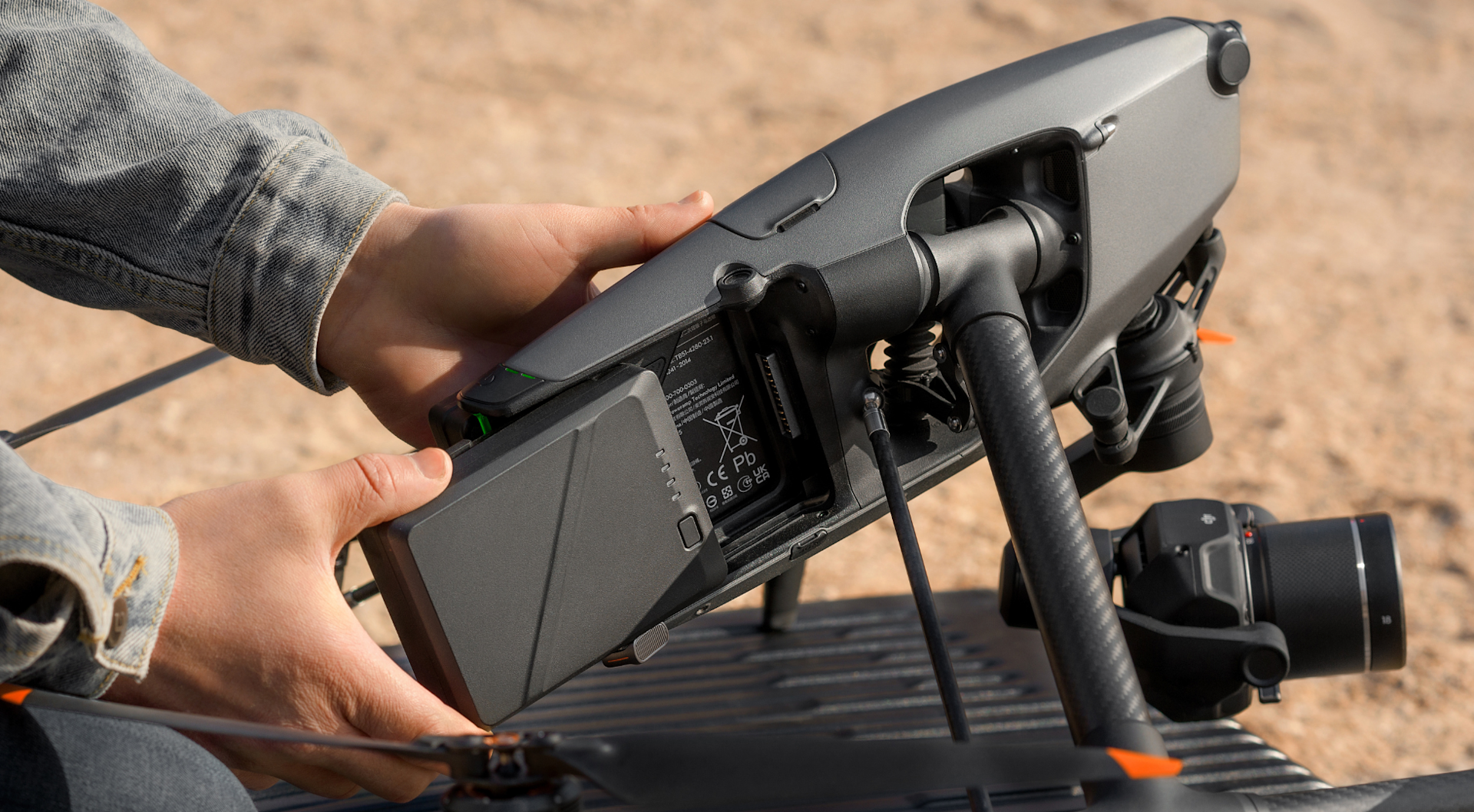
Complementing this, the Inspire 3's Battery Charging Hub can accommodate eight batteries, and in Fast mode, it can charge two batteries to 90% in just 35 minutes and eight batteries to 100% in only 160 minutes.
On the other side of the coin, the Mavic 3 Series 100W Battery Charging Hub can fast charge up to three batteries in sequence. It takes 1 hour and 10 minutes to charge each battery using the DJI 100W USB-C Power Adapter, or 1 hour and 36 minutes using the DJI 65W Portable Charger or DJI 65W Car Charger.
Transmission
The DJI Mavic 3 Pro Cine supports O3+ transmission, while the DJI Inspire 3 supports O3 Pro. Both transmission systems provide strong and stable communication.
The Mavic's maximum transmission distance is 8km (CE), while the Inspire reaches the same distance in single control mode, and 6.4km (CE) in dual control mode. More of dual control mode later in this blog.
Utilising O3+, the Mavic 3 Pro can transmit a 1080p/60fps HD live feed at high frame rates.
On the Inspire 3, both the gimbal camera and FPV camera support 1080p/60fps live feeds and an ultra-low latency of 90 ms. And for the first time, 4K/30fps live feeds are supported with a maximum 5km transmission distance to meet the needs of UHD monitoring and livestreaming on set.
Safety Features
By their very nature, both drones are incredibly safe and reliable.
The Mavic 3 Pro Cine has omnidirectional obstacle sensing and APAS 5.0: The aircraft's high-performance vision computing engine precisely senses obstacles in all directions and plans a safe flight route to avoid them.
Added intelligent features, such as Advanced Return To Home - which is an auto-return function - further benefit flight safety.
But, the DJI Inspire 3 takes flight safety to the next level.
Just like the Mavic 3 Pro Cine, it benefits from omnidirectional obstacle sensing, but it also supports:
Customisable Obstacle Sensing: Enable or disable horizontal, upward, and downward sensing, and manually set an obstacle alert range.
Fisheye Camera: Added to each of the Inspire 3's four landing arms - helping to avoid obstructions from the airframe when the landing gear is raised and allows for horizontal obstacle sensing when the landing gear is lowered.
Integrated Ultra-wide Night-vision FPV Camera: Provides a clear, stabilised, ultra-low-latency view for situational awareness and additional flight safety, day and night.
RTK: Built-in RTK antennas which enable three types of GNSS (GPS, BeiDou, and Galileo) and deliver dual-frequency positioning down to the centimetre level. By activating an RTK network or setting up a D-RTK 2 Mobile Station, users can achieve highly-accurate positioning without mounting any additional modules.
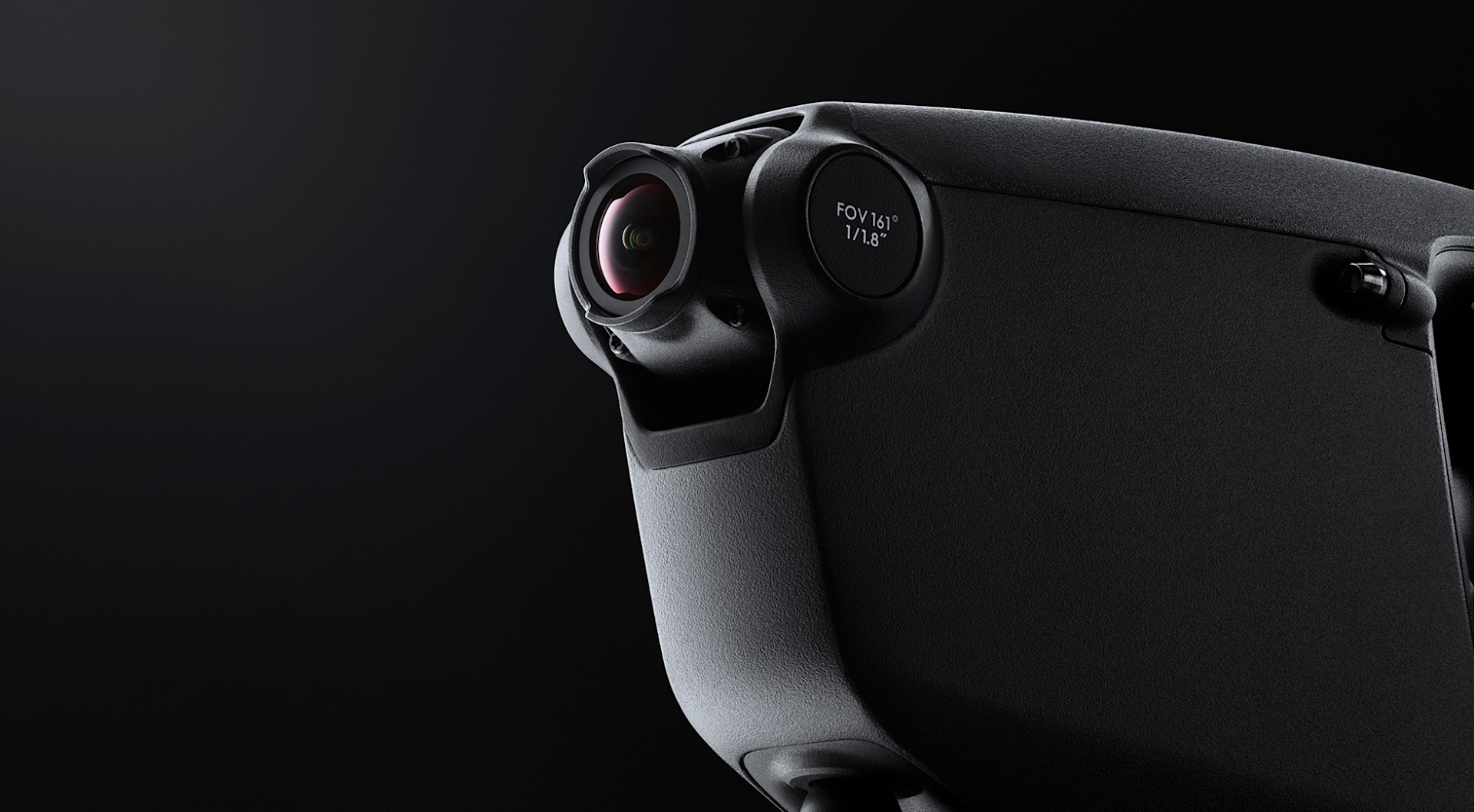
Intelligent Features
The Mavic 3 Pro Cine and Inspire 3 have a suite of intelligent features which help streamline, simplify, and automate high-end content creation.
Mavic 3 Pro Cine includes:
Waypoint Flight: Automated flight experience - Mavic 3 Pro Cine automatically plans a flight route based on the user's pre-set waypoints and can precisely repeat routes.
Cruise Control: Fly in any direction without continually pressing the control sticks.
FocusTrack: The Hasselblad camera and the Medium Tele Camera support FocusTrack, which includes ActiveTrack 5.0, Spotlight, and Point of Interest, enabling stable tracking shots in multiple directions.
MasterShots: Tap to enable MasterShots, and Mavic 3 Pro Cine will automatically shoot, edit, add soundtracks, and generate cinematic footage afterward.
QuickShots: Perform diverse camera movements like Dronie, Rocket, Circle, and Helix.
Panorama: Directly compose a 100MP lossless panorama photo to capture a more breath-taking landscape.
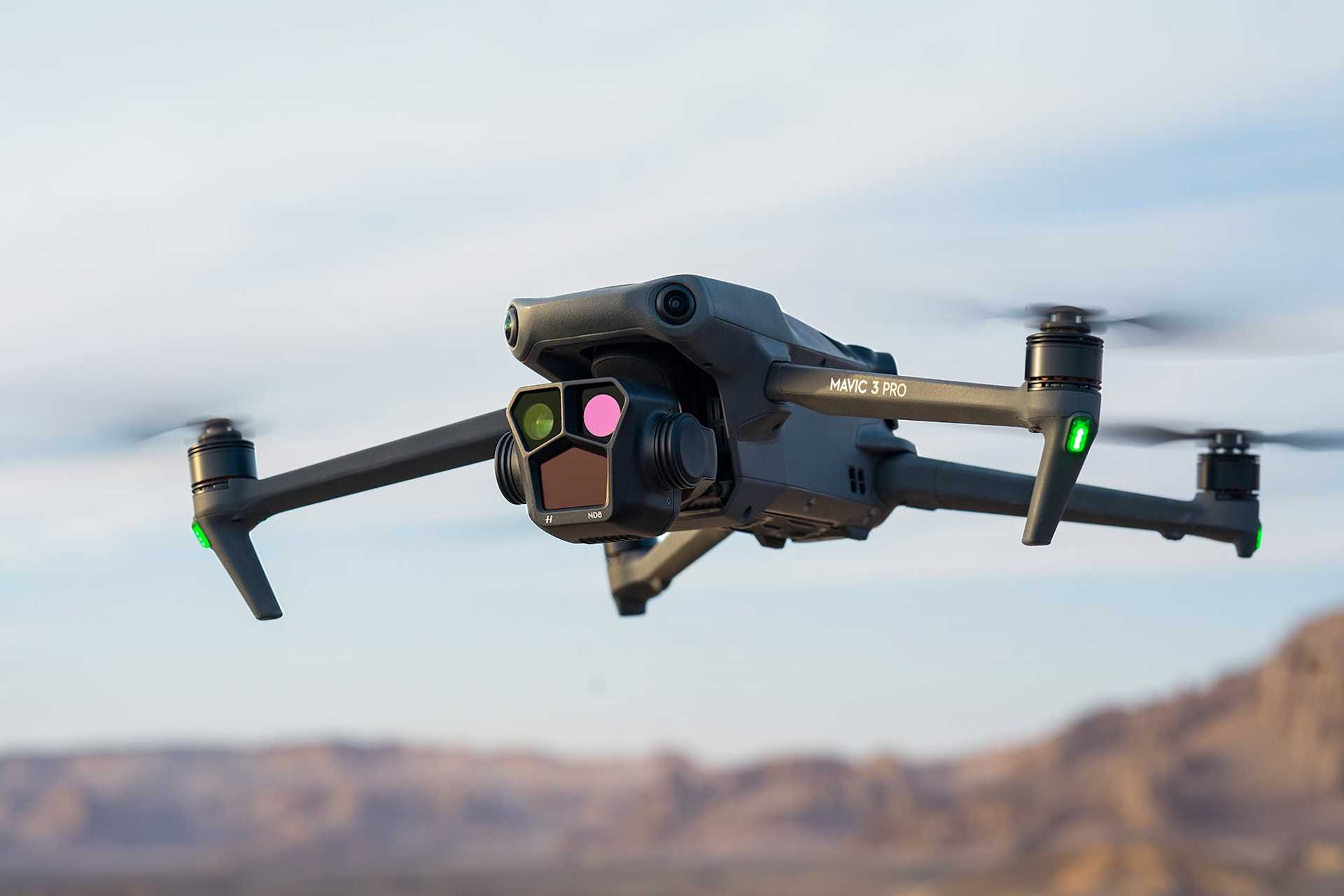
Meanwhile, Inspire 3 includes:
Repeatable Routes: The aircraft will automatically fly on the same route and maintain all pre-set parameters such as altitude, speed, gimbal angle, and camera settings - perfect for difficult one-takes or creating long-duration timelapses.
3D Dolly: Simulates a crane, cablecam, or dolly on film sets. After planning a flight route, the cinematographer can manually control the aircraft to move along the route back and forth while adjusting parameters such as speed and gimbal angle - helping to make shots more effective and efficient.
Spotlight Pro: Provides solo creators with more possibilities. Inspire 3 supports automated subject recognition and locking for people, vehicles, and boats. In Follow mode, the aircraft and gimbal camera orient toward the same direction and remain locked on the subject so that the pilot can get circling shots without manual framing adjustments. In Free Mode, the gimbal camera can stay locked on a subject, while a solo pilot uses the FPV camera to check their surroundings and control the flight route.
While Mavic 3 Pro Cine has some great features, the DJI Inspire 3's suite of intelligent features feel more suited to professional filmmakers.
Controller
The Mavic 3 Pro Cine is compatible with the DJI RC Pro, while the Inspire 3 is used with the DJI RC Plus.
Both are pro-level controllers, but there's a strong argument to say that the DJI RC Plus is an enhanced controller.
Screens
While both RCs are smart controllers, with built-in screens, they do have their differences.
For instance, the DJI RC Plus has a 7-inch, 1,200-nit screen...
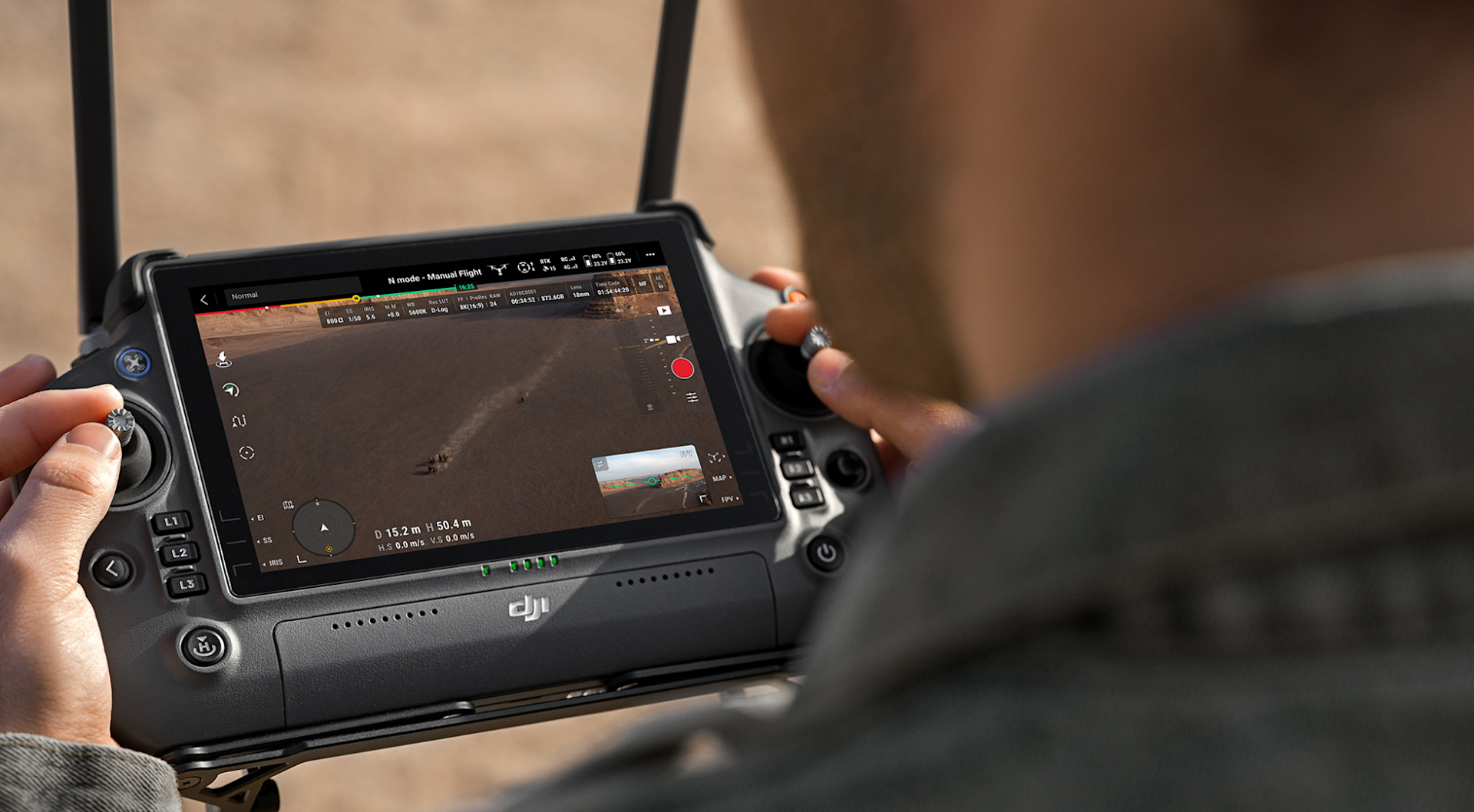
...while the DJI RC Pro has a smaller 5.5-inch, 1,000-nit screen.
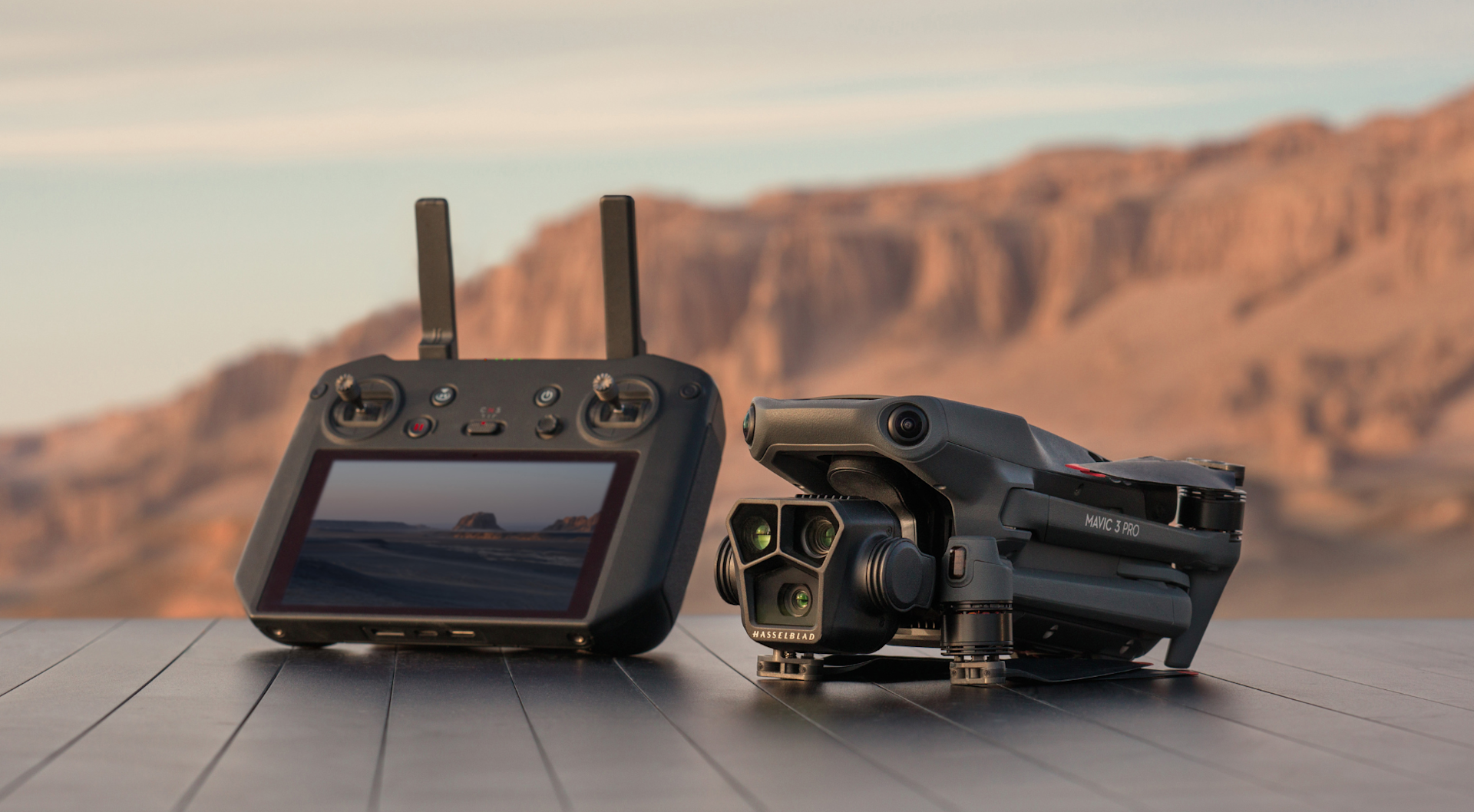
This ensures the DJI RC Plus provides an extraordinary outdoor monitoring experience, especially in bright conditions. It's worth noting that the DJI RC Pro also handled outdoor conditions well, but the DJI RC Plus has the edge with the increased brightness and larger screen size.
Battery Life
The DJI RC Plus has longer endurance, too. It can last for 3.3 hours with its built-in battery, but adding an external battery takes its run time to the six-hour mark. It also supports hot-swapping for more effective operation. In contrast, the RC Plus provides three hours of juice.
App
The DJI RC Plus uses the new DJI Pilot 2 app for Inspire. On top of the classic flight control interface, this app adds a cinema-grade monitoring interface, which allows simple and convenient checking of information like camera exposure, video specifications, focal length, and gimbal angle, easily meeting the monitoring requirements of gimbal operators and DPs.
In contrast, the DJI RC Pro utilises DJI Fly, which is a nifty app which shows flight status (such as signal strength, flying mode, altitude, distance, and battery level) and camera settings (adjust camera parameters with a single tap, quickly switch between shooting modes, and adjust the gimbal angle on the screen), and also features an editing suite.
Dual Control Mode
Another huge advantage of deploying the Inspire 3-DJI RC Plus for filmmakers is the Dual Control Mode.
It means that two remote controllers can receive live feeds and control the drone independently, so the pilot and gimbal operator can be at different positions on set.
If the pilot loses aircraft signal, the gimbal operator is now able to take control of the aircraft to safely return to home or land directly.
DJI Goggles Compatibility
For a more immersive experience, the DJI Mavic 3 Pro Cine is compatible with the DJI Goggles Integra and DJI Goggles 2, as well as the DJI RC Motion 2 which allows operators to control the drone with wrist movements.
DJI PRO Ecosystem
The DJI Inspire 3 is also compatible with the DJI PRO ecosystem, providing further synergy between ground and air crews.
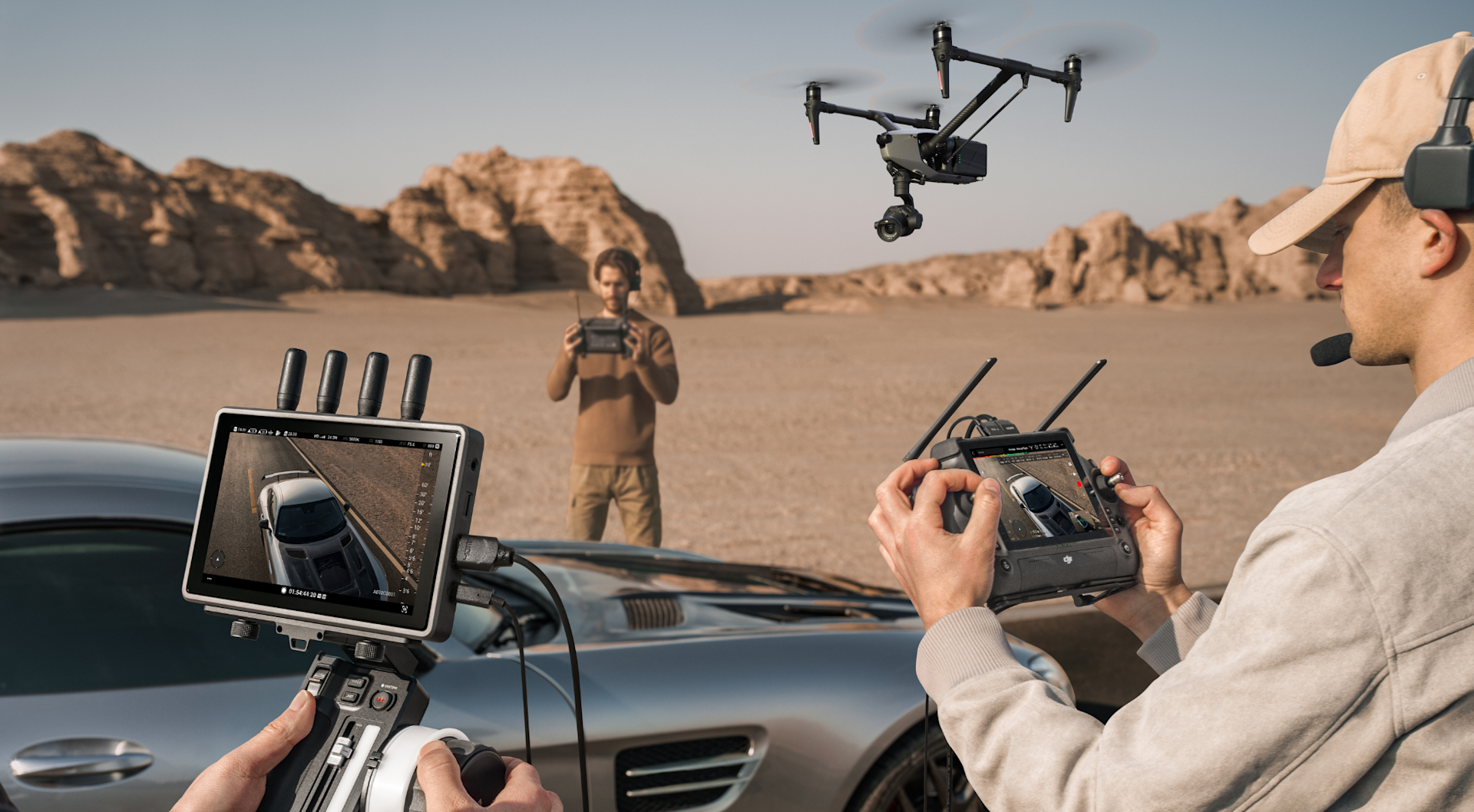
As such, and in addition to RC Plus, the Inspire 3 also allows use of the DJI High-Bright Remote Monitor as a second remote controller. The remote monitor can pair directly with Inspire 3 to receive live feeds, and can even control gimbal and focus when the Ronin 4D Hand Grips are attached. HDMI and SDI ports on the remote monitor can also output live feeds to other monitoring devices.
Price
Price is a key consideration - and there is a major difference between the two drones.
The Mavic 3 Pro Cine will cost around £4,000, while the Inspire 3 will set you back in the region of £15,000 - depending on what set-up you opt for, ie lens options etc.
DJI Mavic 3 Pro Cine Vs DJI Inspire 3: Summary
Engineered for aerial photography and videography, the DJI Mavic 3 Pro Cine and DJI Inspire 3 are quality content-creation drones - and will no doubt tickle the taste buds of pro-filmmakers.
The capabilities of the DJI Inspire 3 make it the ultimate filmmaking drone, and it will likely be the platform of choice for top-end creators, film houses and TV productions.
That said, the Mavic 3 Pro Cine still has a place - and there's every chance that pro-filmmakers will choose to have the Mavic and the Inspire in their arsenal, giving them versatility and creative flexibility, depending on the nature of the job.
After all, many filmmakers have already gone down this route using the previous generation of these drones - namely the Mavic 3 Cine and Inspire 2.
But with the Mavic 3 Pro Cine and Inspire 3 packing serious and notable upgrades on their predecessors, they take filmmaking to the next level.
To start or scale your operations with the DJI Mavic 3 Pro Cine/Inspire 3, contact heliguy™.
